From Habitat magazine - issue 02
What kind of home do you live in? If it’s older, how does it fit into the timeline that is our architectural heritage?
Read on and find out…
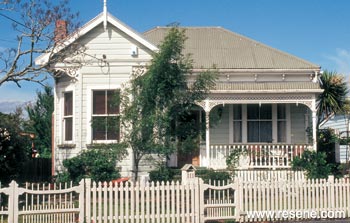
1910 bay villa. Get the look with
Resene Zinc White and Resene Silver Grey.
Simple villas were generally larger than the cottages and Victorian-style homes that preceded them, with four rooms – two each side of a central hallway – and the luxury of an indoor bathroom at the end of the passage. The square floor plan often had a lean-to at the back, housing a wash house and storage. The chimney was integrated into the house, providing back-to-back fireplaces in the sitting room and kitchen. Many elements of the house, such as doors, windows, skirting boards and decorative-work could be bought directly from a timber company.
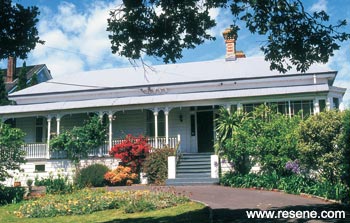
A traditional flat-fronted villa.
Growing out of the verandah cottages of the 1870s, which had four ground-floor rooms, two attic bedrooms and a lean-to at the back, the bay villa was a larger home for city living. The rectangular shape and verandah are reminiscent of the earlier cottages, but with the addition of a cantilevered gable roof over a bay window. Bay villas commonly follow a single-storey, central hall layout, with a ceiling stud height of 3-3.6 metres. Decoration on the gable and verandah, and the bull-nosed verandah roof, are common features.
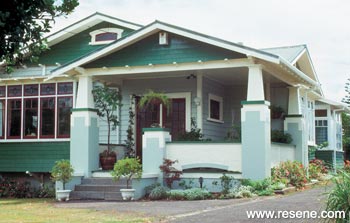
Resene Jet Stream, Resene Deep Teal and Resene Bulgarian Rose.
The move away from the villa was a slow one, but the highly popular Californian bungalow was an adventurous step, with its gabled front, low-pitched roof, exposed eaves and coloured fanlights in the casement windows. Shingles were used on the walls – especially on gables and bay windows – the ceiling height came down, and a lot of the external decoration disappeared.
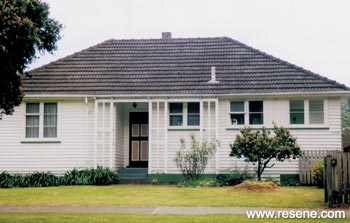
The ever-popular state house.
The first of the state houses to be built in significant numbers were completed in 1936, and they set the pattern for the familiar – and often highly sought after – state house of today. No new developments to the style occurred during The Depression and any innovation immediately thereafter was curbed by WW2, especially as building materials became scarce.
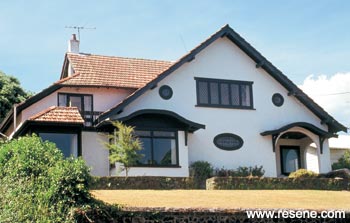
Get the look with Resene Alabaster and Resene Burnt Umber.
A combination of art deco and modern design, the Spanish-styled house of the 1940s was a huge break away in style from the past. It continued a trend towards more variety in planning, but was generally constructed from stucco on a plaster framework. The pitched roof required for our rainfall was hidden behind parapet walls to give a hacienda-style impression.
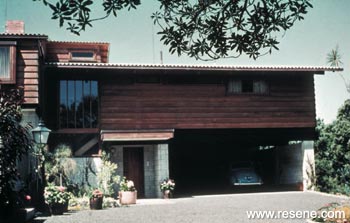
A distinctive Group house.
We have a distinctive lifestyle and this was eventually interpreted by a variety of architects, including the modernist Architectural Group and the work of Sir Miles Warren. These structures aimed to be functional buildings that simply suited their purpose. They were “a machine for living in”, with a low-pitched roof and strong horizontal lines, an open-plan format, floor-to-ceiling windows and easy indoor/outdoor flow. Orientation to views and sun were now important issues.

Sturdy and functional. Get the look with Resene Zinc White and Resene Mahogany.
In the ‘60s, house designs changed again and planning became yet more sophisticated. Bungalow builders adopted the large windows, open plan configuration and indoor/outdoor flow of the modern house, but tried to lend the home its own individual features. Increased demand led to the construction of low-cost flats built lengthwise on a section, while in the cities, older houses were divided into flats as demand for accommodation grew.
So, what do you live in? If it’s more modern, you know it intimately. If it’s older, it’s worth looking into, just in terms of how it might have been and how you could sensitively amend it.
At Resene, we know an awful lot about colour, but that doesn’t mean we know everything. That’s why, when we were developing a designer colour palette, we asked Karen Walker for her input. And it’s why we’ve been working with renowned conservation architect Ian Bowman to relaunch our Heritage Colour Palette.
The aim of this re-released range is to recreate the authentic shades traditionally used across New Zealand’s historical periods of house design. It acknowledges a growing trend towards restoring older homes in a way that is true to the original character of the building, even if there have been renovations and additions in the intervening years.
To underscore the authenticity of the collection, Ian Bowman meticulously documented for us the source building, structure or evidence for each colour. It’s important to understand that the range of colours available in the past was somewhat limited, and that changes between the various periods were gradual.
In the early colonial period – 1840-1870 – imported paints or homemade limewashes, in one- or two-toned colour schemes, were typical. Ochres, umbers, creams and fawns were common on cob and earth buildings, with the same shades used on timber homes to imitate stone.
Moving into the mid-Victorian 1870s to 1890s, the same earthy tones were used, along with dark reds, browns and greens for trim, sashes and doors. Striped verandah roofs were common, with the darker colours alternating with creams, and interior colours including crimsons, buffs, blues, greys, browns, reds, tans, olives, terracottas, greens, roses and golds.
The 1890s to 1914 marked the end of Victoria and the reign of Edward, and down this end of the world, houses continued to sport a three-colour palette, with light weatherboards, dark trim and a different dark colour for sashes and doors. This was occasionally reversed, with the weatherboards dark and the trim lighter. Verandah brackets and mouldings, finials, door panels and gable framework were often picked out in different colours to the surrounding shades.
In the Dominion period, from 1914 – 1945, the ranges of style and colour use expanded enormously. The Californian bungalow became hugely popular, dressed in off-whites, creams and buffs, with dark greens, dark reds and blacks for the trim and the shingles under gables and bay windows. Alternatively, the entire house was painted or stained black.
From 1925 to the late ‘40s, the art deco and moderne styles adopted off-whites, pale greens, pale pinks and light browns, with details picked out in strong, contrasting greens, oranges and blues. Stained glass and lead-light windows added a greater complexity of interior colour.
So, there you go! If you live in an older home, which period does it fit? What colour could it be?
For more information on our heritage buildings, visit www.historic.org.nz.
words: Rachel Macdonald, with thanks to UNITEC School of Architecture
pictures: Supplied by the University of Auckland
Search habitat magazine stories
Printed copies of habitat highlights are available from late March 2024 at Resene ColorShops and resellers, while stocks last. You can view back issues of habitat magazine online.
Specifiers:
If you have an idea, project or story that you think would suit habitat, we’d love to hear from you. Please drop us an email with your details and include photos if submitting a project.
Sign up for a DIY card and Save! Australia | New Zealand